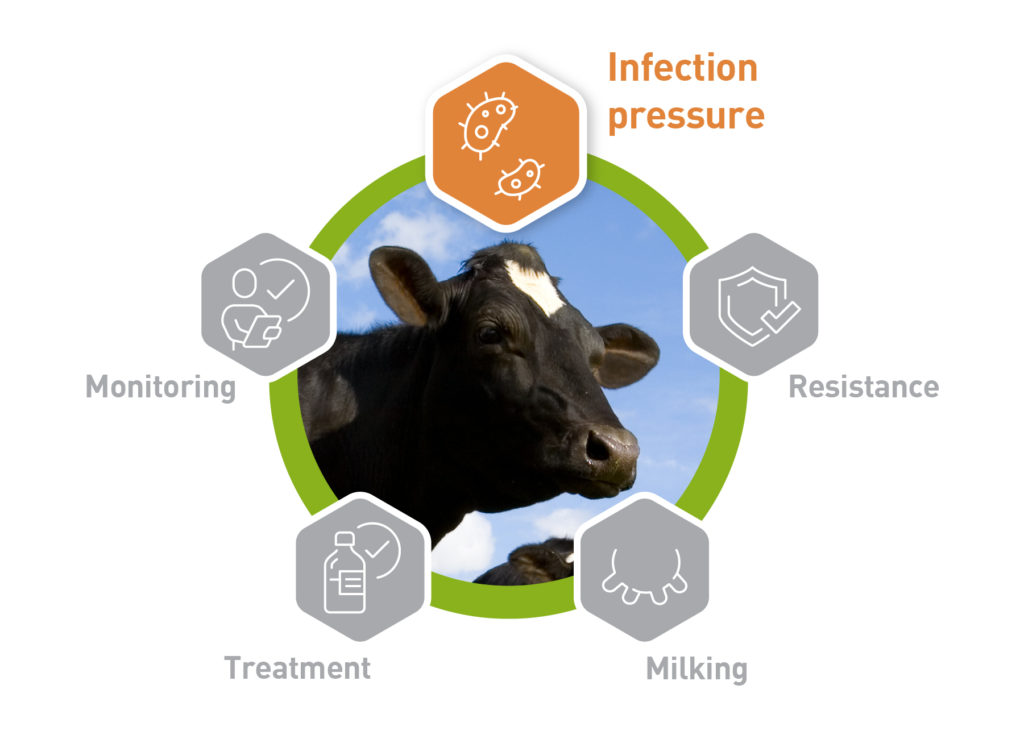
Hygiene scoring is a good indicator of the infection pressure on the farm: the bacterial load in the environment and the risk of infection. The dirtier the environment, the dirtier the cow – and dirt usually carries bacteria and other potential pathogens.
Of course there’s dirt and dirt. Sawdust on the cow’s flanks from dry, well-bedded free stalls is not as bad as manure spots on the udder.
=> Use the hygiene score card in VetIMPRESS/Multi Data/Cleanliness or from AHDB at

Hygiene score: measuring the infection pressure
The most important hygiene score is the hygiene of the udder. Clean teats and udder have a lower risk of udder infections. Farmers should therefore aim at having cows with clean teats and udders when they enter the milk parlour.
Science has confirmed a significant association between the prevalence of intramammary contagious pathogens and udder hygiene score: the dirtier the cows: the higher the SCC and the risk of mastitis.

Udder infections are virtually always caused by bacteria that have entered the udder via the teat canal. Most times this happens during milking or shortly after milking.
=>Use the hygiene score card in VetIMPRESS/Multi Data/Cleanliness or from AHDB at
Indicators that help determine the source of dirt
Not just the amount of dirt but in particular the parts of the body that are soiled will give an indication as to the source of the dirt and potential contamination. They will indicate to the farmer what part of the barn needs particular attention when it comes to cleaning.
- Dirt on the teat and udders either comes from the place where the cows lie down, or from the places where the cows stand and walk.
- Hygiene score of the lower legs will reflect the cleanliness of floors and passageways.
- The flanks and the lower abdomen provide a picture of how dry and clean the resting places are: the free-stalls or loose housing areas.
- A soiled tail base is often a sign of loose manure/diarrhoea.
How to carry out hygiene scoring
Hygiene scoring is relatively straightforward, and relatively objective. To get a good estimate of cow hygiene, it should be assessed in a group of cows, as one single very clean or very dirty cow is not representative.
The most straightforward one is the 3-point scale, ranging from 1 (clean) to 3 (dirty). Five body areas are generally used to determine hygiene scores:
- Tail base
- Upper hind legs
- Ventral abdomen
- Udder
- Lower hind legs
=>Use the hygiene score card in VetIMPRESS/Multi Data/Cleanliness or from AHDB at
The hygiene scores for udder and lower hind legs are significantly associated with the SCC, according to a study involving nearly 1,200 dairy cows. In a study using a 5-point scale, each 1-unit change in the udder/hind limb hygiene score was associated with an additional 40,000 to 50,000 cells/ml.

This cow has too much dirt on her flanks and abdomen, although her feet are quite clean. This suggests that her resting area is not clean and dry, and a potential source of udder infections.
Older cows and early-lactation cows are dirtier
Hygiene scores tend to increase as cows advance in parity. This is likely due to the fact that the udder of older cows is closer to the floor and is more easily splashed with manure.
Early-lactation cows tend to be dirtier and have looser manure consistency than late-lactation cows. This is probably related to the higher dry matter intake. And since cows in early lactation are more susceptible to mastitis, it is critical that they are kept as clean as possible in this period.

Deep straw-bedded pens are excellent for cow comfort but are a bigger risk for udder infections. Also here the hygiene score of the cows provides a picture of how clean and dry the bedding is.
